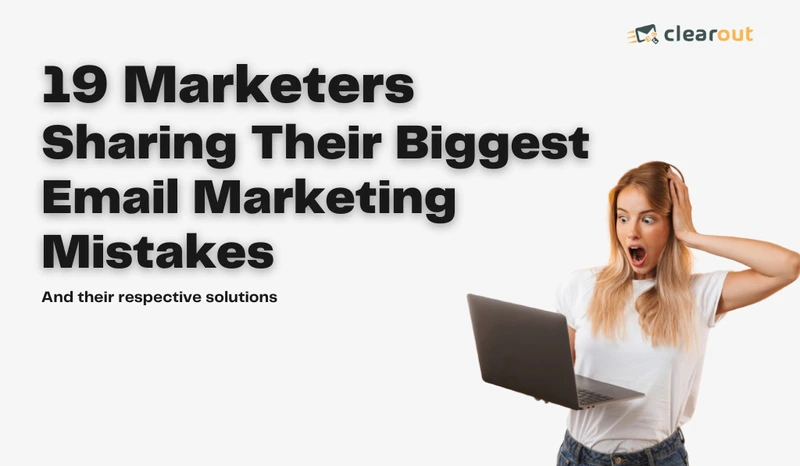- Products
- ProspectSQL/MQL list building with high levels of personalization, real-time data enrichment and prospect search
- Email FinderFind individual or bulk emails by entering the person & company name or domain
- Email VerifierVerify emails addresses individually, in bulk or through API, with 99% accuracy
- Clearout For SheetsVerify email addresses directly on Google Sheets with Clearout for sheets add-on
- ClearoutPhoneValidate phone numbers across 240+ countries in bulk, quick or real time validation Free Tools
- Disposable Email Checker
- Reverse LinkedIn Profile Lookup Tool
- Reverse Email Lookup Tool
- Email List Cleaner
- Resource
- Pricing
- Integrations
- Enterprise
- Login
19 Marketers Share Their Biggest Email Marketing Mistake

Email marketing has stood the test of time and is still considered one of the favorite marketing channels. However, with changing user behavior the email marketing practices need modifications. Not adapting to such changes leads to mistakes, making efforts, and campaigns unsuccessful.
It's always better to learn from mistakes of others so here are 19 Marketers sharing their biggest email marketing mistakes.
It's always better to learn from mistakes of others so here are 19 Marketers sharing their biggest email marketing mistakes.
1. Carlos Obregon, Bloom Digital Marketing

The biggest email marketing mistake we have made is not sending out a test email to ourselves first. It is easy to overlook small typos on your message, but by sending a test email to your own team you can identify the involuntary typos, wrong dates, incorrect amounts and perhaps broken links too. How many times have you received a marketing email that instead of your actual name says {Dear First Name} or something of that sort?
Of course, if you mistakenly send out an email message with an error you can follow up with a correction email, but this is far from ideal. If an error is made, the right approach is to own it and apologize to your readers. Remember that every single one of them is only human and has made mistakes in the past.
It goes without saying that you should also take advantage of spell and grammar checkers.
Of course, if you mistakenly send out an email message with an error you can follow up with a correction email, but this is far from ideal. If an error is made, the right approach is to own it and apologize to your readers. Remember that every single one of them is only human and has made mistakes in the past.
It goes without saying that you should also take advantage of spell and grammar checkers.
2. Chris Sloane, Heaviside Group

The biggest email marketing mistake we've made in the past is not taking email marketing seriously. Email still is a huge customer acquisition channel if done correctly, and we left plenty of business on the table by ignoring it. Now we use email in two ways, both of which drive revenue for us.
First, we market to our current and previous customers with valuable content that is simply meant to stay relevant in their inbox. It's more of a soft-sell approach, as people will come in from these messages over time and convert. Having that presence also allows us to sneak in new product announcements and/or deals on occasion which drives direct revenue.
The second way is more subtle but just as important - our email list provides a snapshot of our actual buying customer profile, which we use to generate powerful custom and lookalike audiences for Facebook Ads marketing. You can't find a more relevant list than that!
First, we market to our current and previous customers with valuable content that is simply meant to stay relevant in their inbox. It's more of a soft-sell approach, as people will come in from these messages over time and convert. Having that presence also allows us to sneak in new product announcements and/or deals on occasion which drives direct revenue.
The second way is more subtle but just as important - our email list provides a snapshot of our actual buying customer profile, which we use to generate powerful custom and lookalike audiences for Facebook Ads marketing. You can't find a more relevant list than that!
3. Amanda Thomas, Konstruct Digital

My biggest email marketing mistake: not utilizing it enough for my own company.
Being in the digital marketing space, and having worked with 100s of clients, I know first hand that email marketing can have one of the highest ROIs of any channel by increasing sales immensely.
However, sometimes when you're too close to the product it's easy to think, "but do people really want to get an email from me?" Sometimes as agency owners we get the old “shoemaker's children” syndrome where we don’t always do the best work for ourselves.
So, of course, I had to use the same thinking that we apply to our clients:
--- What do we know about, that our audience wants to know about, and how can we make it interesting?
Putting yourself in the shoes of the receiver helps frame the strategy and understand the value to the receiver.
If someone has opted into your email list, they’ve given permission that they want to receive content from you or they think you have something interesting to offer. The implicit contract on that is ensuring you deliver on that expectation.
Being in the digital marketing space, and having worked with 100s of clients, I know first hand that email marketing can have one of the highest ROIs of any channel by increasing sales immensely.
However, sometimes when you're too close to the product it's easy to think, "but do people really want to get an email from me?" Sometimes as agency owners we get the old “shoemaker's children” syndrome where we don’t always do the best work for ourselves.
So, of course, I had to use the same thinking that we apply to our clients:
--- What do we know about, that our audience wants to know about, and how can we make it interesting?
Putting yourself in the shoes of the receiver helps frame the strategy and understand the value to the receiver.
If someone has opted into your email list, they’ve given permission that they want to receive content from you or they think you have something interesting to offer. The implicit contract on that is ensuring you deliver on that expectation.
4. Jason Schulz, 5Tales Digital Marketing

The biggest Email marketing mistake we did when we first started with email marketing was not verifying the emails we got. This led to bounces and lower deliverability. Over time our domain reputation took a hit because we did not know that we should be sending emails to just valid emails.
Using a tool like a Clearout helps to get rid of invalid emails and make sure our emails land in the inbox. This combined with other best practices like having SPF, DKIM and DMARC set up, avoiding using spam keywords in the emails and sending emails that add value to our subscribers, led us to get a positive ROI from our email marketing efforts. We have since then started offering email marketing services to our clients as well.
Using a tool like a Clearout helps to get rid of invalid emails and make sure our emails land in the inbox. This combined with other best practices like having SPF, DKIM and DMARC set up, avoiding using spam keywords in the emails and sending emails that add value to our subscribers, led us to get a positive ROI from our email marketing efforts. We have since then started offering email marketing services to our clients as well.
5. Ryo Chiba, Topic

I've had a tendency in the past to spend too much time iterating on email copy, trying to find a unique angle or hook to stand out. When a campaign returned with disappointing results, I found it hard to continue iterating when I spent so much time finessing the details.
To counter this, I've recently started having a writing partner put together a quick first draft for any email campaign I'm developing. I then go into the draft and edit it to my standards. Even if my partner's draft is very rough, working this way is much faster for me.
Editing someone else's work removes my ego from the process, making it much easier to say exactly what I want to. Removing ego also makes it easier to learn from failed campaigns and iterate. There's something about sharing the burden of rejection that makes it easier to recover from failure.
To counter this, I've recently started having a writing partner put together a quick first draft for any email campaign I'm developing. I then go into the draft and edit it to my standards. Even if my partner's draft is very rough, working this way is much faster for me.
Editing someone else's work removes my ego from the process, making it much easier to say exactly what I want to. Removing ego also makes it easier to learn from failed campaigns and iterate. There's something about sharing the burden of rejection that makes it easier to recover from failure.
6. Austin Cline, Sitemap

Our biggest email marketing mistake was not analyzing and paying attention to how our emails were impacting our sales leads. When a prospect would fill out our contact form, we would send a generic email sequence over a couple of weeks. The emails talked about the history of our agency and our services. We hadn't put much thought into it and had a low open rate and saw people weren't engaging with the email content.
To fix this, our sales team made a list of the most common questions and objections they heard from potential clients. We had our marketing team use this information to create emails and subject lines that helped answer questions and hit on the core issues our clients faced.
The result of this work was that our emails actually nurtured leads. We noticed right away that our open rates improved by 15%. Our sales team got warm leads and ultimately closed more sales.
To fix this, our sales team made a list of the most common questions and objections they heard from potential clients. We had our marketing team use this information to create emails and subject lines that helped answer questions and hit on the core issues our clients faced.
The result of this work was that our emails actually nurtured leads. We noticed right away that our open rates improved by 15%. Our sales team got warm leads and ultimately closed more sales.
7. Dan Fries, Blue Tree Digital PR

The biggest mistake email marketers make (and that probably includes everyone else on this list) is using automated mail merge tools to try and scale their outreach. Nothing gets marketers more excited than the word "scale"... they will literally froth at the mouth with an opportunity to do more work with less effort.
The issue with this mindset is that scale is almost always gained at the expense of quality. We do not use any automated tools at Blue Tree; rather, we painstakingly write every email pitch individually and send them manually. More upfront work, but the results are incredible. We tend to get around 50-60% open rates and 20-30% response rates across the board.
The issue with this mindset is that scale is almost always gained at the expense of quality. We do not use any automated tools at Blue Tree; rather, we painstakingly write every email pitch individually and send them manually. More upfront work, but the results are incredible. We tend to get around 50-60% open rates and 20-30% response rates across the board.
8. Chris Porteous, My SEO Sucks
About two years ago, I ran an email marketing campaign for a client. We were pretty confident with the copy and the layout, but our biggest mistake was that we didn’t test how the email messages would look on mobile device screens. Of course, we realized the mistake during the middle of the execution of the campaign.
We learned that some of the graphics we incorporated in the messages weren’t loading right, or sometimes weren’t loading at all, depending on the email app a particular recipient was using. We also found that the copy we composed looked a bit wordy when reading from smaller screens such as those on mobile devices.
Although we made some adjustments throughout the campaign, I can’t help but feel that we might have missed an opportunity to maximize the effectiveness of our campaign because of we kind of underestimated how many of our subscribers were checking their mails through mobile.
We learned that some of the graphics we incorporated in the messages weren’t loading right, or sometimes weren’t loading at all, depending on the email app a particular recipient was using. We also found that the copy we composed looked a bit wordy when reading from smaller screens such as those on mobile devices.
Although we made some adjustments throughout the campaign, I can’t help but feel that we might have missed an opportunity to maximize the effectiveness of our campaign because of we kind of underestimated how many of our subscribers were checking their mails through mobile.
9. Adam Walters, muON Marketing

The biggest mistake I have done in email marketing was flat out not doing it. I've set up successful campaigns for my own clients but when it came to my own efforts for my own business I fell flat. As I'm writing this I'm thinking, "in the time to go through the hoops of writing this I could be setting up an email campaigning automating my lead generation," but here I am. 🙂
So what I have learned is time management and prioritizing what's important and what's not is crucial to success. Automate what you can, but the human touch when needed, and learn from trial and error.
So what I have learned is time management and prioritizing what's important and what's not is crucial to success. Automate what you can, but the human touch when needed, and learn from trial and error.
10. Darren A. Smith, Making Business Matter

The biggest mistake I have made when sending marketing emails is making it all about us.
There is a formal for trust and it consists of 4 parts; Reliability, Credibility, and Intimacy, and these are divided by Self Orientation.
- Reliability is about doing something when you say you will.
- Credibility is about being an expert on a subject.
- Intimacy is knowing other people and sharing about you, with other people.
- Self-orientation is about not thinking that the world revolves around you.
I have previously, and see many people send marketing emails that are about them:
- 'Here's my new website - Take a look'.
- 'We've just hired Bob and he's great'.
- 'Our new product is our latest in our catalogue'.
No-one cares.
Make the email about what problems you can solve for them. For example:
- 'Have the power to justify your training spend with a proven ROI'.
- 'Don't just send people on training courses. Achieve real behavioral change.'
- 'Work with people that understand your industry'.
There is a formal for trust and it consists of 4 parts; Reliability, Credibility, and Intimacy, and these are divided by Self Orientation.
- Reliability is about doing something when you say you will.
- Credibility is about being an expert on a subject.
- Intimacy is knowing other people and sharing about you, with other people.
- Self-orientation is about not thinking that the world revolves around you.
I have previously, and see many people send marketing emails that are about them:
- 'Here's my new website - Take a look'.
- 'We've just hired Bob and he's great'.
- 'Our new product is our latest in our catalogue'.
No-one cares.
Make the email about what problems you can solve for them. For example:
- 'Have the power to justify your training spend with a proven ROI'.
- 'Don't just send people on training courses. Achieve real behavioral change.'
- 'Work with people that understand your industry'.
11. Dan Christensen, Morningdove Marketing

Out of the many email marketing mistakes I've made, I feel like "going halfway" was the biggest one. Let me explain. If I send 25 emails and get one person to open it, but I don't close them as a client, that's NOT a failure. The failure was that I didn't send 2500 emails.
Gathering data and testing to see what works is a process and one that requires a lot of effort. Getting into the email marketing game is so easy that a teenager with a laptop could do it.
However, mastering it takes a combination of tenacity, copywriting skills, analytical thinking, and certain kinds of automation. I didn't go deep enough at the beginning, and that led to the "it just doesn't work" mindset. So what I learned is that one key to "trying" something as a method of marketing is to actually TRY it. Go deeper than your competition, spend the time, and then at the end you can actually see with your own results whether it's a worthy tactic or not.
Gathering data and testing to see what works is a process and one that requires a lot of effort. Getting into the email marketing game is so easy that a teenager with a laptop could do it.
However, mastering it takes a combination of tenacity, copywriting skills, analytical thinking, and certain kinds of automation. I didn't go deep enough at the beginning, and that led to the "it just doesn't work" mindset. So what I learned is that one key to "trying" something as a method of marketing is to actually TRY it. Go deeper than your competition, spend the time, and then at the end you can actually see with your own results whether it's a worthy tactic or not.
12. Jeremy Moser, uSERP

Plain and simply: automating too much is a big mistake. As a brand mention agency, we try to partner with big websites to submit top-tier content pieces. Reaching out generically asking to contribute is a surefire way to
(1) build a bad reputation and
(2) get a near-zero response rate.
To combat this, we've abandoned almost all email automation and now focus on quality over quantity.
We personalize each message by spending time in different SEO tools conducting content analysis to see how we can deliver the most value to each prospect. By taking this personalized approach, we send fewer emails and get more responses. We craft a brand image that is value-driven, rather than value-seeking. We establish stronger relationships that last years, rather than one-time collaborations.
Automating is great for low-level tasks, but when you need to reach prospects who are traditionally bombarded with emails, you can't automate and expect success. You need to personalize and create a process for research on each prospect. Hire a VA, scale it, and reap the rewards of better email marketing. Imagine you have a medical practice, you won't automate most tasks as it's your expertise that patients need. Having a healthcare VA in this case is the best way to go as patients will still get personaliized attention.
(1) build a bad reputation and
(2) get a near-zero response rate.
To combat this, we've abandoned almost all email automation and now focus on quality over quantity.
We personalize each message by spending time in different SEO tools conducting content analysis to see how we can deliver the most value to each prospect. By taking this personalized approach, we send fewer emails and get more responses. We craft a brand image that is value-driven, rather than value-seeking. We establish stronger relationships that last years, rather than one-time collaborations.
Automating is great for low-level tasks, but when you need to reach prospects who are traditionally bombarded with emails, you can't automate and expect success. You need to personalize and create a process for research on each prospect. Hire a VA, scale it, and reap the rewards of better email marketing. Imagine you have a medical practice, you won't automate most tasks as it's your expertise that patients need. Having a healthcare VA in this case is the best way to go as patients will still get personaliized attention.
13. Bobbie Bailey, M Agency

Marketing isn’t a one-size-fits-all affair.
To get the biggest ROI out of your email marketing efforts, you not only have to go where your customers are, but you also have to make a meaningful connection while consistently staying in front of them. It's not one or the other and this is where most marketers go wrong. Follow the golden rule, “Do unto others as they want done themselves”, be aware of what they want to know, or hear from your organization. For instance, if your list wants dog treats and you offer them catnips, you’re in trouble. Have a clean list, add to them regularly, and segment intentionally. Learn what your audience wants to know or hear from your organization, and then learn how to automate it.
Don’t waste your energy people. Figure out your audience and take time to automate follow up with meaningfully crafted emails based on where they are in the sales funnel.
To get the biggest ROI out of your email marketing efforts, you not only have to go where your customers are, but you also have to make a meaningful connection while consistently staying in front of them. It's not one or the other and this is where most marketers go wrong. Follow the golden rule, “Do unto others as they want done themselves”, be aware of what they want to know, or hear from your organization. For instance, if your list wants dog treats and you offer them catnips, you’re in trouble. Have a clean list, add to them regularly, and segment intentionally. Learn what your audience wants to know or hear from your organization, and then learn how to automate it.
Don’t waste your energy people. Figure out your audience and take time to automate follow up with meaningfully crafted emails based on where they are in the sales funnel.
14. Sefi Grossman, Loop

Me vs You
One of the biggest mistakes I found (and incredibly easy to forget) is that the most effective technique in email marketing is positioning your message so that it addresses the customer’s pain or desires, not what you are selling. Regardless of whether you are selling a product, a service, a program, etc… it is very easy to have the blinders on and only focus on the features rather than the benefits.
From the subject line to the body of your message, whether it’s plain text or a beautifully laid out HTML, not positioning using “you” is a lost opportunity to activate your audiences’ right brain (which is where all decision making happens). Some business owners and marketers might think that because your customers or prospects have already opted-in from a website or an ad that you can move beyond “you” since they are deeper in the funnel, but positioning your product or service in their world is something that should never stop.
One of the biggest mistakes I found (and incredibly easy to forget) is that the most effective technique in email marketing is positioning your message so that it addresses the customer’s pain or desires, not what you are selling. Regardless of whether you are selling a product, a service, a program, etc… it is very easy to have the blinders on and only focus on the features rather than the benefits.
From the subject line to the body of your message, whether it’s plain text or a beautifully laid out HTML, not positioning using “you” is a lost opportunity to activate your audiences’ right brain (which is where all decision making happens). Some business owners and marketers might think that because your customers or prospects have already opted-in from a website or an ad that you can move beyond “you” since they are deeper in the funnel, but positioning your product or service in their world is something that should never stop.
15. Téa Liarokapi, Moosend

My most significant email marketing blunder would be poor segmentation and personalization. Seeing as those are the two most essential elements for any email marketing campaign, neglecting their use wasn't a great move.
By segmenting the audience, a brand can create a meaningful message that will cater to that specific segment's needs. Personalized content will make the email look and feel tailor-made specifically for each individual.
For example, using the prospect's name on the email subject line, made a huge difference. After all, an email is a knock on someone's door. They'll open the door if someone that sounds familiar calls their name.
Lastly, not using AI and machine learning was something that did cost conversion. AI can see patterns a data analyst just can't; it can ultimately create a 1:1 personalization model. When we started using it, we saw a considerable increase in our open and click-through rates, as the email was talking precisely about the things a prospect was interested in.
By segmenting the audience, a brand can create a meaningful message that will cater to that specific segment's needs. Personalized content will make the email look and feel tailor-made specifically for each individual.
For example, using the prospect's name on the email subject line, made a huge difference. After all, an email is a knock on someone's door. They'll open the door if someone that sounds familiar calls their name.
Lastly, not using AI and machine learning was something that did cost conversion. AI can see patterns a data analyst just can't; it can ultimately create a 1:1 personalization model. When we started using it, we saw a considerable increase in our open and click-through rates, as the email was talking precisely about the things a prospect was interested in.
16. Nick Beske, PointClick.io

Often times new marketers send an email and fill it with all sorts of information but forget to include the most important bit: Having a CTA.
If after reading your email, the reader does not know what he is supposed to do next, he is most likely not to do anything.
Suppose you sent an email about your web design services and don't include a CTA like “book a call from here”, then the recipient is just gonna read your email and not know what to do next even if they are interested.
People are super busy these days and don't have time to think. We have to nudge them into the direction we want them to go in.
So make sure you always have a clear CTA in your email. And just one CTA so that your reader is not confused.
If after reading your email, the reader does not know what he is supposed to do next, he is most likely not to do anything.
Suppose you sent an email about your web design services and don't include a CTA like “book a call from here”, then the recipient is just gonna read your email and not know what to do next even if they are interested.
People are super busy these days and don't have time to think. We have to nudge them into the direction we want them to go in.
So make sure you always have a clear CTA in your email. And just one CTA so that your reader is not confused.
17. Jeff Gapinski, Huemor

Testing, especially across multiple email clients can not be understated in terms of how important it is.
We made the mistake of not using Litmus testing for deployment once. We instead decided to test the emails holistically across a few different email clients ourselves.
This did not pan out well. A large subset of the audience receiving the email was using an older version of outlook we had not tested for. Ultimately, we lost about 20% of the campaign's opportunity right off the bat because the emails appeared broken.
You can spend your time crafting the perfect opening lines, split testing layouts, and building the perfect list, but if it doesn't get to them intact, you've stumbled over the finish line in a major way.
So test, test, and then test again using PROPER email testing tools before you send anything out.
We made the mistake of not using Litmus testing for deployment once. We instead decided to test the emails holistically across a few different email clients ourselves.
This did not pan out well. A large subset of the audience receiving the email was using an older version of outlook we had not tested for. Ultimately, we lost about 20% of the campaign's opportunity right off the bat because the emails appeared broken.
You can spend your time crafting the perfect opening lines, split testing layouts, and building the perfect list, but if it doesn't get to them intact, you've stumbled over the finish line in a major way.
So test, test, and then test again using PROPER email testing tools before you send anything out.
18. Shaurya Jain, Attention Always Marketing

The Biggest email marketing Mistake we made was to ignore having a welcome sequence for our email list. We sent out emails whenever we wanted to sell our services or products but the subscriber did not really hear back from us as soon as he signed up. We kept wondering why no one buys our services after we send out the emails. The reason was they did not trust us enough. After creating a welcome sequence, we were able to build trust among our subscribers and nurture them into hot leads.
To do this we exclusive content for our email subscribers that they could not get on our blog. We also made a small product which people could easily afford. This puts them in the mentality that we sell stuff here and it's not just about free stuff.
To do this we exclusive content for our email subscribers that they could not get on our blog. We also made a small product which people could easily afford. This puts them in the mentality that we sell stuff here and it's not just about free stuff.
19. Deepak Shukla, Pearl Lemon Email marketing Agency

Not setting up my mail merges properly has in the past led us to really burning our list. Silly things such as getting the first name wrong or the company name incorrect is the quickest way of course to piss someone off.
Other issues that come into the mix can include scraping data where the name is capitalized or has some small oddities that you can only identify through a manual look at the data - and when this ISN'T did...well the (lack of) results speak for themselves
Often time it's the basics you get wrong - and this was definitely an example of that!
Other issues that come into the mix can include scraping data where the name is capitalized or has some small oddities that you can only identify through a manual look at the data - and when this ISN'T did...well the (lack of) results speak for themselves
Often time it's the basics you get wrong - and this was definitely an example of that!
Recent Posts
01 Jul 2025
Best Zoho CRM Integrations for Sales & Marketing in 2025
Discover the top Zoho CRM integrations in 2025 categorized by use case. Explore how each tool's key ...
01 Jul 2025
Sales Automation in 2025: The Guide to Close More Deals Faster
Struggling with manual sales workflows? Follow this guide to explore the sales automation use cases, ...
25 Jun 2025
Top 6 Email Finder APIs in 2025 for All Use Cases
Looking for a reliable Email Finder API? Explore the top 6 email finder APIs of 2025—compare key fea ...
17 Jun 2025
Top 10 Email Spam Checker Tools Tested & Reviewed (2025)
Check out the top 10 email spam checker tools to avoid junk folders. Compare features, ratings & use ...
06 Jun 2025
How To Create a Lead Magnet That Converts in 2025
Looking for more leads? Read how to create a high-converting lead magnet in 2025 with step-by-step g ...
Prospecting ,Email Finder & Email Verification Service
Prospecting ,Email Finder & Email Verification Service
Expand your reach by discovering and verifying the ideal prospects.
Sign up & get 100 free credits | No Credit Card required

